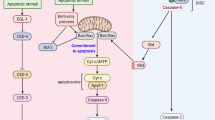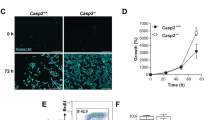Abstract
E2F is a family of transcription factors which regulates cell cycle and apoptosis of mammalian cells. E2F-1-3 localize in the nucleus, and preferentially bind pRb, while E2F-4 and 5 have no nuclear localization signal and preferentially bind p107/p130. E2F-6 suppresses the transcriptional activity of other E2F proteins. DP-1 and 2 are heterodimeric partners of each E2F protein. Using tetracycline-responsive promoters, here we compared the effects of ectopic expression of E2F-1, DP-1 and E2F-4 on cell cycle progression and apoptosis in Chinese hamster cell lines. We found that E2F-4, as well as DP-1 and E2F-1, induced growth arrest and caspase-dependent apoptosis. E2F-4 did not have a marked effect on cell cycle progression, while E2F-1 induced DNA synthesis of resting cells and DP-1 arrested cells in G1. Ectopic expression of E2F-4 did not activate E2F-dependent transcription. Our results suggest that expression of E2F-4 at elevated levels induces growth arrest and apoptosis of mammalian cells through a mechanism distinct from E2F-1 and DP-1.
This is a preview of subscription content, access via your institution
Access options
Subscribe to this journal
Receive 50 print issues and online access
$259.00 per year
only $5.18 per issue
Buy this article
- Purchase on Springer Link
- Instant access to full article PDF
Prices may be subject to local taxes which are calculated during checkout










Similar content being viewed by others
References
Adams PD and Kaelin Jr. WG. . 1996 Curr. Tp. Microbiol. Immunol. 208: 79–93.
Adnane J, Shao Z and Robbins PD. . 1995 J. Biol. Chem. 270: 8837–8843.
Bargou RC, Wagener K, Bommert K, Arnold W, Daniel PT, Mapara MY, Grinstein E, Royer HD and Dorken B. . 1996 J. Exp. Med. 183: 3–10.
Bates S, Phillips AC, Clark PA, Scott F, Peters G, Ludwig RL and Vousden KH. . 1998 Nature 395: 124–125.
Blake MC and Azizkhan JC. . 1989 Mol. Cell. Biol. 9: 4994–5002.
Bremner R, Cohen BL, Sopta M, Hamel PA, Ingles CJ, Gallie BL and Phillips RA. . 1995 Mol. Cell. Biol. 15: 3256–3265.
de Stanchina E, McCurrach ME, Zindy F, Shieh SY, Ferbeyre G, Samuelson AV, Prives C, Roussel MF, Sherr CJ and Lowe SW. . 1998 Genes Dev. 12: 2434–2442.
DeGregori J, Kowalik T and Nevins JR. . 1995 Mol. Cell. Biol. 15: 4215–4224.
DeGregori J, Leon G, Miron A, Jakoi L and Nevins JR. . 1997 Proc. Natl. Acad. Sci. USA 94: 7245–7250.
de la Luna S, Burden MJ, Lee C-W and La Thangue NB. . 1996 J. Cell Sci. 109: 2443–2452.
Dirks PB, Rutka JT, Hubbard L, Mondal S and Hamel PA. . 1998 Oncogene 17: 867–876.
Dyson N. . 1998 Genes Dev. 12: 2245–2262.
Ferreira R, Magnaghi-Jaulin L, Robin P, Harel-Bellan A and Trouche D. . 1998 Proc. Natl. Acad. Sci. USA 95: 10493–10498.
Field SJ, Tsai F-Y, Kuo F, Zubiaga A-M, Kaelin Jr. WG, Livingston DM, Orkin SH and Greenberg ME. . 1996 Cell 85: 549–561.
Gossen M and Bujard H. . 1992 Proc. Natl. Acad. Sci. USA 89: 5547–5551.
Hateboer G, Kerkhoven RM, Shvarts A, Bernards R and Beijersbergen RL. . 1996 Genes Dev. 10: 2960–2970.
He S, Cook BL, Deverman BE, Weihe U, Zhang F, Prachand V, Zheng J and Weintraub SJ. . 2000 Mol. Cell. Biol. 20: 363–371.
Helin K, Wu C-L, Fattaey AR, Lees JA, Dynlacht BD, Ngwu C and Harlow E. . 1993 Genes Dev. 7: 1850–1861.
Hsieh JK, Fredersdorf S, Kouzarides T, Martin K and Lu X. . 1997 Genes Dev. 11: 1840–1852.
Huang DY and Prystowsky MB. . 1996 J. Biol. Chem. 271: 1218–1225.
Johnson DG, Schwarz JK, Cress WD and Nevins JR. . 1993 Nature 365: 349–352.
Kamijo T, Weber JD, Zambetti G, Zindy F, Roussel MF and Sherr CJ. . 1998 Proc. Natl. Acad. Sci. USA 95: 8292–8297.
Lindeman GJ, Dagnino L, Gaubatz S, Xu Y, Bronson R, Warren HB and Livingston DM. . 1997 Proc. Natl. Acad. Sci. USA 94: 5095–5100.
Lindeman GJ, Dagnino L, Gaubatz S, Xu Y, Bronson RT, Warren HB and Livingston DM. . 1998 Genes Dev. 12: 1092–1098.
Magae J, Wu C-L, Illenye S, Harlow E and Heintz NH. . 1996 J. Cell Sci. 109: 1717–1726.
Magae J, Illenye S, Tejima T, Chang Y-C, Mitsui Y, Tanaka K, Omura S and Heintz N. . 1997 Oncogene 15: 759–769.
Magae J, Illenye S, Chang Y-C, Mitsui Y and Heintz NH. . 1999 Oncogene 18: 593–605.
Milbrandt JD, Heintz NH, White WC, Rothman SM and Hamlin JL. . 1981 Proc. Natl. Acad. Sci. USA 78: 6042–6047.
Müller H, Moroni M, Vigo E, Peterson BO, Bartek J and Helin K. . 1997 Mol. Cell. Biol. 17: 5508–5520.
Phillips AC, Bates S, Ryan KM, Helin K and Vousden KH. . 1997 Genes Dev. 11: 1853–1863.
Pomerantz J, Schreiber-Agus N, Liegeois NJ, Silverman A, Alland L, Chin L, Potes J, Chen K, Orlow I, Lee HW, Cordon-Cardo C and DePinho RA. . 1998 Cell 92: 713–723.
Qin X-Q, Livingston DM, Kaelin Jr. WG and Adams P. . 1994 Proc. Natl. Acad. Sci. USA 91: 10918–10922.
Robertson KD and Jones PA. . 1998 J. Cell. Biol. 18: 6457–6473.
Sellers WR, Rodgers JW and Kaelin Jr WG. . 1995 Proc. Natl. Acad. Sci. USA 92: 11544–11548.
Shan B and Lee W-H. . 1994 Mol. Cell. Biol. 14: 8166–8173.
Shan B, Durfee T and Lee W-H. . 1996 Proc. Natl. Acad. Sci. USA 93: 679–684.
Shull S, Heintz NH, Perisamy M, Manohar M, Janssen YMW, Marsh JP and Mosman BT. . 1991 J. Biol. Chem. 266: 24398–24403.
Slansky JE and Farnham PJ. . 1996 BioEssays 18: 55–62.
Treier M, Staszewski LM and Bohmann D. . 1994 Cell 78: 787–798.
Verona R, Moberg K, Estes S, Starz M, Vernon JP and Lees JA. . 1997 Mol. Cell. Biol. 17: 7268–7282.
Wade M, Kowalik TF, Mudryj M, Huang ES and Azizkhan JC. . 1992 Mol. Cell. Biol. 12: 4364–4374.
Weintraub SJ, Prater CA and Dean DC. . 1992 Nature 358: 259–261.
Weintraub SJ, Chow KN, Luo RX, Zhang SH, He S and Dean DC. . 1995 Nature 375: 812–815.
Wells JM, Held P, Illenye S and Heintz NH. . 1996 Mol. Cell. Biol. 16: 634–647.
Wells JM, Illenye S, Magae J, Wu C-L and Heintz NH. . 1997 J. Biol. Chem. 272: 4483–4492.
Wu C-L, Zukerberg LR, Ngwu C, Harlow E and Lees JA. . 1995 Mol. Cell. Biol. 10: 2536–2546.
Wu X and Levine AJ. . 1994 Proc. Natl. Acad. Sci. USA 91: 3602–3606.
Yamasaki L, Jacks T, Bronson R, Goillot E, Harlow E and Dyson N. . 1996 Cell 85: 537–548.
Zhang Y, Xiong Y and Yarbrough WG. . 1998 Cell 92: 725–734.
Acknowledgements
We are grateful to H Bujard (Universität Heidelberg, Germany), C-L Wu, E Harlow (MGH Cancer Center, Boston, USA) and K Helin (European Institute of Oncology, Milan, Italy) for providing plasmids and antibodies. This work is in part supported by American Cancer Research Faculty Award to NH Heintz, the Vermont Cancer Center, the Lake Champlain Cancer Research Organization, and NIH grant #GM54726 to NH Heintz and by Center of Excellence grant from STA, Japan to Y Mitsui, and a project grant to K Saida and Y Mitsui of Research and Development for the Elucidation of Biological Functions from the Ministry of International Trade and Industry of Japan.
Author information
Authors and Affiliations
Rights and permissions
About this article
Cite this article
Chang, YC., Nakajima, H., Illenye, S. et al. Caspase-dependent apoptosis by ectopic expression of E2F-4. Oncogene 19, 4713–4720 (2000). https://doi.org/10.1038/sj.onc.1203833
Received:
Revised:
Accepted:
Published:
Issue Date:
DOI: https://doi.org/10.1038/sj.onc.1203833
Keywords
This article is cited by
-
Proapoptotic role of novel gene-expression factors
Clinical and Translational Oncology (2007)
-
Facilitation of adenoviral wild-type p53-induced apoptotic cell death by overexpression of p33ING1 in T.Tn human esophageal carcinoma cells
Oncogene (2002)



